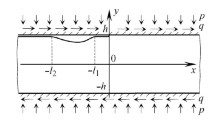Abstract
Two simple opening-mode finite strip problems are discussed. The discussion is limited to a dynamic steady-state solution within the realms of the classical theory of elasticity. It is shown that by using Fourier transform methods, the problems are reduced to equations of the Wiener-Hopf type. The complete stress and displacement distributions are difficult to obtain, and no attempt is made to arrive at this. By application of the asymptotic properties of the Fourier transform the stress-intensity factor is, instead, derived.
Résumé
On discute deux problèmes simples de modes d'ouverturre d'un défaut dans une bande de dimensions finies.
On se limite dans la discussion à une solution dynamique instantanée dans le domaine de la théorie classique de l'élasticité. On montre que, en utilisant la méthode des transformations de Fourier, les problèmes se réduisent à des équations du type Wiener-Hopf. Il est difficile de déterminer complètement les distributions des contraintes et des déplacements. Aussi ne tente-t-on pas d'y arriver. Par contre, il est possible de déduire le facteur d'intensité de contraintes en appliquant les propriétés asymptotiques de la transformée de Fourier.
Zusammenfassung
Zwei einfache Probleme über den Öffnungsverlauf eines Defektes in einem Blech endlicher Abmessungen werden besprochen.
Die Erörterung beschränkt sich auf eine augenblickliche dynamische Lösung auf dem Gebiete der klassischen Elästizitätstheorie. Man zeigt, daß mit Hilfe der Fourier-Transformation das Problem in die Lösung von Gleichungen des Typs Wiener-Hopf überführt werden kann. Die Bestimmung der vollständigen Verteilung der Spannungen und Verschiebungen ist jedoch schwierig und ein Versuch these Frage zu lösen wurde auch nicht unternommen. Es wurde hingegen unter Anwendung der asymptotischen Eigenschaften der Fourier-Transformation der Spannungsintensitätsffaktor abgeleitet.
Similar content being viewed by others
References
G. C. Sih and E. P. Chen, Moving cracks in a finite strip under tearing action, Journal of the Franklin Institute, 290 (1970) 25–35.
B. Noble, Methods based on the Wiener-Hopi technique for the solution of partial differential equations, International series of monographs on pure and applied mathematics, Pergamon Press (1958).
J. R. Rice, Comment on “Stresses in an infinite strip containing a semi-infite crack” by W. G. Knauss, Journal of Applied. Mechanics, 34 (1967) 248–249.
J. R. Willis, A comparison of the fracture criteria of Griffith and Barenblatt, Journal of the Mechanics and Physics of Solids, 15 (1967) 151–162.
G. P. Cherepanov, On the crack propagation in solids, International Journal of Solids and Structures, 5 (1969) 863–871.
Author information
Authors and Affiliations
Rights and permissions
About this article
Cite this article
Nilsson, F. Dynamic stress-intensity factors for finite strip problems. Int J Fract 8, 403–411 (1972). https://doi.org/10.1007/BF00191102
Received:
Revised:
Issue Date:
DOI: https://doi.org/10.1007/BF00191102




